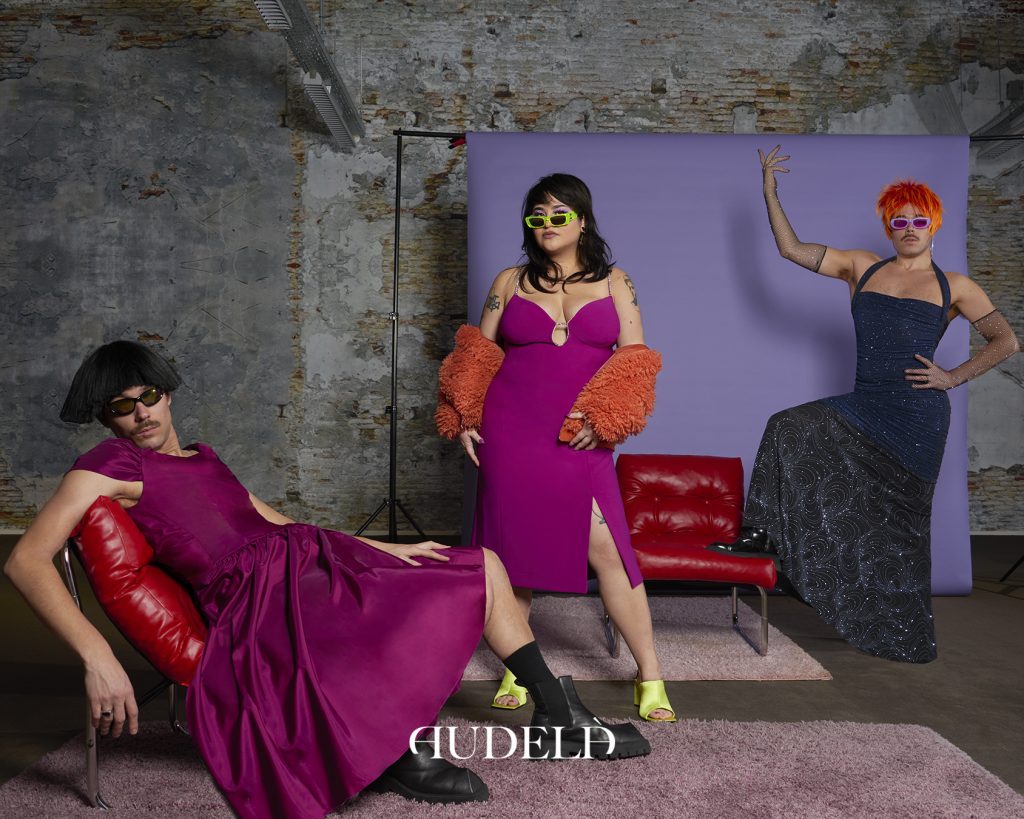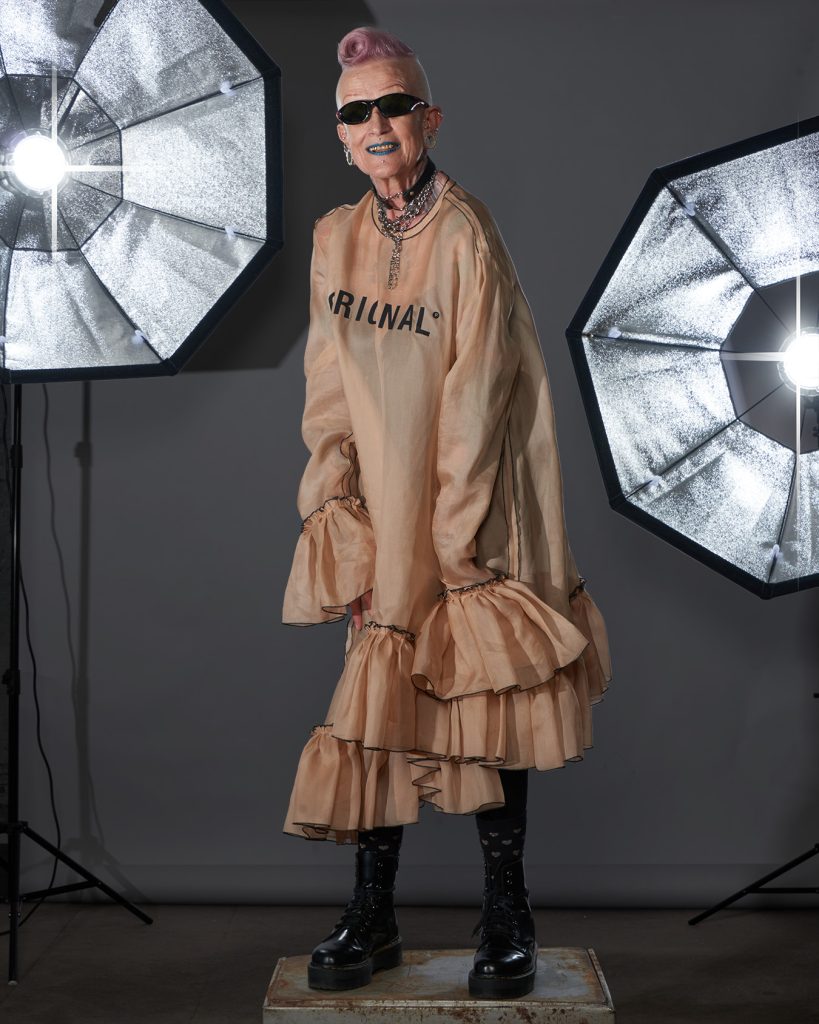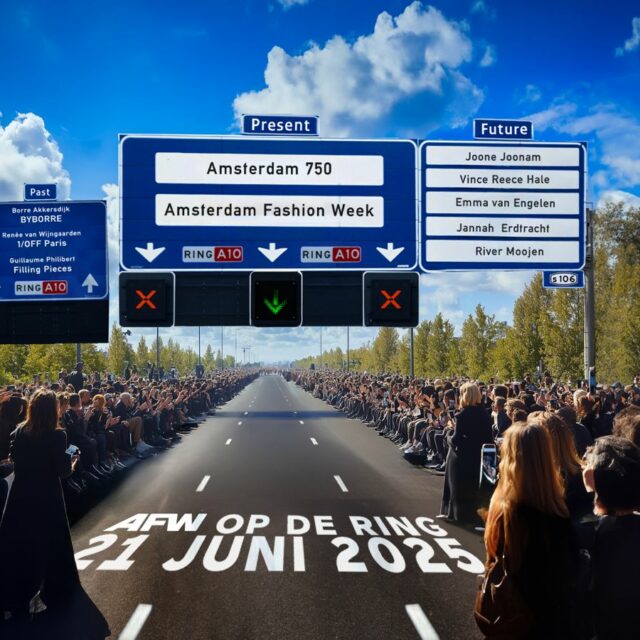Swarmed with buzzwords like upcycled, curated, handpicked and pre-owned, customised and sustainably sourced, the fashion industry and its fashion gurus are obsessed with holy grail vintage finds and the hard-to-find places to snatch them from. As currently, there’s no bigger symbol of being a true fashion insider than flaunting a rare 90’s Tom Ford-era Gucci piece, AFW decided to delve into the world of curated second-hand shops, following the lead of some of the most prominent sellers on the Dutch market. Unravelling the elements that make a vintage platform successful, this week, we met up with the founders of audelà. Charlotte van Remmen and Cédric Pradel tell us the story of their identity and the community they have built alongside it, the combination of vintage and new, and the importance of queer visibility.
The beginnings – building the community
Cédric: “Me and Charlotte have been friends for a long time. Charlotte being a project manager in her day-to-day life and me being a fashion photographer, we both got struck with a lot of free time during the COVID pandemic. I had started to sort out my closet and sell some items on Depop, which gained a fair amount of popularity. Rather quickly after that, I decided to ask Charlotte to curate some clothing items together. We found that Depop wasn’t really doing our selection justice, so then we started building our own website and before we knew it, we were at the Chamber of Commerce and to register our own company.”
Charlotte: “We were very lucky with the fact that we have a lot of inspiring people around us who all wanted to help, so that we could start this journey without it being very scary. It’s extremely important to us that the identity of our clothes match the wearer, and so we didn’t want random models to wear our clothes without connecting to them, even to the point where we wanted to call the platform “No models allowed”. This of course sounds a bit extreme but our approach is that the identity of our brand comes first and are very protective of that. Everything we do and communicate has to feel gender queer, expressive, and above all flamboyant.”
Cédric: “We started with a select group of supporters existing of our overlapping friend groups, however, when we held our official opening, a whole new group of people connected with us and that was such a gift. We found new models for example, who felt represented by us and our store. These new models were initially customers that just came by one day. I think that interplay of people coming in the store and inspiring us with their presence, and our clothes inspiring those people in return, is very special.”

Introducing a new formula: vintage meets merch
Cédric: “When you sell vintage you usually only have one exemplar of everything, which comes with certain benefits of course when you think of the attraction of exclusivity, but it also makes it harder to build a strong brand identity. We are not a standard second-hand shop and we don’t want to be. By mixing second-hand with new items, we’re trying to break new ground and initiate a new formula. The first thing we ever produced ourselves is our audelà cap. That’s really the best symbol of our community that we’ve created so far. We then tried to introduce that cap to our community and it worked out so well! People who don’t want to look very explicit themselves, but who do have a lot of affinity with it and want to support the people that do so; those are the people who wear that cap. Without wearing a rainbow flag, our new items kind of say “hey guys, I’m open to this.” It almost gives me goosebumps to realise that this is something we have achieved. If you only have second-hand clothing, the identity beyond the visual style you create with the web shop and the physical store is difficult to translate. Therefore, we see our self-produced items as official merch for our community and an extension of our brand identity.”
Charlotte: “We’re also currently working on a new line of items in collaboration with two of our friends whom are skilled designers. It is however still very much in the making. We’ve noticed that with vintage, it’s hard to find items that are just perfect and to have a selection that matches your brand in the way you envision. That’s where customised or self-produced items come in to fill up this gap.”
Choosing, picking and styling
Cédric: “Our secret recipe is that we have found certain addresses where we’re able to pick out the pearls of the bunch. We don’t buy bags of 50 kilos only to end up with a ton of leftovers, and only handpick what our community might be interested in. We sometimes also buy 25 kg bags of white shirts for example, but we use them to make upcycled items. With the opening of our studio, we noticed that these customised pieces work very well and that there is certainly a market for them.”
Cédric: “In the beginning, we had a “nothing is ugly” mentality, and we focused a lot on the styling aspect of vintage. We did change that a bit based on what our customers gravitated towards. We noticed that people don’t come to us to buy a pair of jeans, but rather to buy their most extravagant item. We’ve had people come in to shop an outfit for their own wedding. In the beginning we were a bit afraid of being too niche, but in the end it’s much more fun to be big in your niche than opening another store that offers the same stuff as the masses. We want to be super inclusive, but fashion is of course also special because of its exclusivity. That balance between safe space and inclusion vs. exclusivity was a difficult one in the beginning. For example, our expression is now more “femme”, because we also think there is more need for that. I think brands that say they are gender free are very quickly more masculine because that is seen as safe. A woman in a suit is fine but a man in a skirt is considered strange, therefore we want to be more of a representation for that side of the spectrum.”
Charlotte: “Every second-hand item has a gender connected to it in a stereotypical men or women’s department stance, we’ve created an environment that encourages our customers to let go of these stereotypes and tend to source more items that are stereotypically femme for the reasons Cédric just mentioned.”

Dissecting and expanding the meaning of audelà
Cédric: “Our identity as audelà is really the only thing that was set in stone from the beginning. The choices of our models, which holidays we do and don’t participate in, and which group of people we want to vouch for are so much engrained in the DNA of the platform, so that part is rock solid. The scope of what audelà can be physically however, is flexible. We were actually just having a conversation about the word “store”. We don’t really want to call our space a store because we associate that word with something other than what audelà is. A store is a place you walk in, where there’s racks and a cash register with someone behind it asking if you want to pay by cash or card. In that respect, we are more of a studio. We are always working here, and regularly hold photoshoots while the studio is open for public. There’s no defined territory for the customer and we don’t keep anything closed off or “behind the scenes”. Whether I’m photographing, we’re planning new events, or there are stylists looking for pieces for their next shoot.”
Charlotte: “Sometimes we feel like we are walking seven different paths. We have a web shop, we organise events, we have the upcycling and customising business in the making, and we have our own freelance jobs on the side. We are still searching within certain aspects of the company, but on the other hand, we have established the aesthetics and vibe very naturally from the start. It’s not a marketing ploy but it comes very much from within us.”
Creating queer visibility
Charlotte: “A lot of our friends work in the nightlife and creative industries, so we have an endless pool of connections within the queer community. There is a queer gym in Amsterdam that we distribute flyers for, there is a fund for trans people to which you can transfer money every month to sponsor their transition, which we try very hard to promote in our studio.”
Cédric: “There is a lot of love for the queer community in the nightlife sector. Society however sometimes forgets that the people within this community also exist during the day, and I think that by setting up audelà this became really apparent to us. This community should be allowed to be visible during the daytime as well, so we also want to encourage people who are working on this cause.”
Photo credits
Coverphoto:
Models: @angelboy.dorien, @theblaquewomxn, @__diothe1st, @junodijkshoorn, @basicangel___
Photographer: @cedricpradel
Models: @graafmaurice, @maniquehendricks, @sandergraaf
Photographer: @cedricpradel






